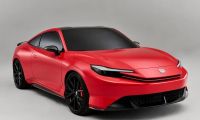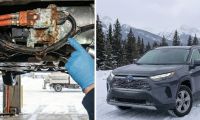Aerodynamics is an interesting field of engineering and design. In the automotive world, we all have come to be convinced that a jellybean shape is the certain outcome and that a large frontal area is the big enemy. But what if those assumptions are wrong?
In a new press release, Nissan outlines some of the design challenges it faced when shaping the new Ariya to slice through the wind. What we found of most interest was a statement by Sarwar Ahmed, an aerodynamics engineer at Nissan Europe. Mr. Ahmed states that, "The wheels and tires contribute around a third of the vehicle drag." Imagine that these components, which seem to be out of the direct path of the wind, contribute so much. That struck us as a big surprise. Thinking of that in its inverse, it means that the aerodynamic drag created by the entire front of the vehicle can contribute no more than 67% of the total.
Tesla isn't kidding when it puts aero wheels on a Model 3 apparently.
John Goreham is a long-time New England Motor Press Association member and recovering engineer. Following his engineering program, John also completed a marketing program at Northeastern University and worked with automotive component manufacturers. In addition to Torque News, John's work has appeared in print in dozens of American newspapers and he provides reviews to many vehicle shopping sites. You can follow John on Twitter, and view his credentials at Linkedin












Comments
I wonder how much of this
Permalink
I wonder how much of this depends on the type of vehicle tested? I would suspect that SUVs, trucks and crossovers have more wheel drag because they sit higher in the air, with more of their area directly exposed to air resistance and turbulence. Plus if you start with open wheel designs that catch the air, then improvements are more easily seen when the new wheels are more aerodynamic. When you look at today's most aerodynamic production cars like the Tesla Model S and the Lucid Dream Air, they do have aerodynamic wheels, but it is only part of many contributing elements. The most aerodynamic vehicle coming into production this year is the Aptera, and it does have full wheel fenders, plus the front wheels are separated from the body to gain maximum aerodynamic efficiency. This contributes to the Aptera using only 100 watt-hours per mile (half as much as other EVs).
I wonder too. If the wheels
Permalink
In reply to I wonder how much of this by DeanMcManis (not verified)
I wonder too. If the wheels on a slippery EV like this are 1/3 I wonder what they are on non-EV models? I also discovered that the underbody contributes double-digit drag. My take-away from this is that making the front smaller and more perfect is not really going to get you much. Worth doing, but the bottom, rear, and wheels contribute to a lot of drag. I can't wait for the Aptera crash tests. The reporting is going to be fun. :)
Definitely, gas powered cars
Permalink
Definitely, gas powered cars don't have the smooth underbody of an EV, because there are so many protruding underbody bits like the engine exhaust, driveshaft and differential (when applicable), and so many trucks and SUVs have tall, blunt noses. I do wonder if the results of this study relate more to where new gains can be made on cars that are already aerodynamic. So if you have a spent bar of soap design with aggressive, sporty wheels, the highest gain will not come from the part of the design that is already working well. As far as the Aptera's crash testing goes, I think that it will do better than many 4 wheeled cars. Their earlier body shell had the highest roof crush rating of any tested car. Jay Leno said you don't need to wear a driving helmet in the Aptera because you are essentially driving inside of one big helmet.